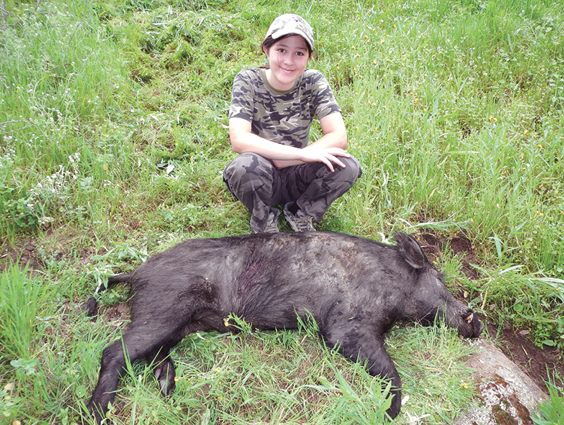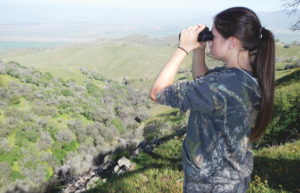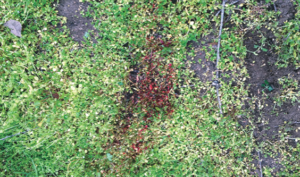
BY TIM E. HOVEY
It doesn’t matter how good a hunter you are, sooner or later you’ll have to deal with following or finding a wounded animal or tracking that animal after the shot to where it died. Whether it’s a poor shot placement or just a tough critter, unless you hit them in the spine or the head, in my experience, animals rarely fold right where they’re hit.
This means that eventually you’ll have to search for an animal that is bleeding and wounded or sustained a lethal shot and died out of view of the hunter. Before we go running through the bushes looking for blood, let’s back up a bit. To avoid having to track blood or blindly move through the wilderness looking for a dead animal, in some instances, all hunters have to do is keep shooting.
I can’t tell you how many times I’ve had to tell friends to shoot again immediately after the initial shot on big game. There always seems to be a lag in time and action after that first shot and in my opinion, it’s a missed opportunity to make recovery easier. Regardless of skill level, they all believed that the animal would simply crumble where they stood after the first shot. I love my friends and I have hunted with them for decades, but without hesitation, I can say that this has never happened.

I’ve always been religious when it comes to quick follow-up shots — so much so that I am already moving through that second shot process in my head before I take the first shot. Squeeze the trigger, keep my head down and eyes on the target, work the bolt completely, back on target, squeeze again. In all reality, it took you longer to read that last sentence than it would’ve taken me to send off a second shot. If an animal is stumbling after the first shot or falls and then gets back up and starts to move away, you owe it to the animal and yourself to keep shooting.
After the shot, you have a decision to make. If the animal fell where it stood and you see it unmoving and apparently dead, you should approach cautiously and do what you need to do to take care of the animal. If the animal is clearly wounded and took off, you need to give it time to expire. Most wounded animals travel a short distance and bed down. Given time, they will expire in these areas. However, if you haphazardly start chasing the animal, bumping him from his bed, chances are you will never find him.
After the shots, I’ll quietly hike to where the animal was standing when the first shot was taken. The goal here is to confirm a hit, and you do that by finding blood. If blood is detected, I’ll determine if its lung blood or meat-wound blood, mark the location and back out. Lung blood is often frothy and bright red. Blood from a meat wound is darker and often doesn’t flow as freely or in the quantity of lung blood. Regardless of what type of blood you find, mark where you found it, back out and give it time.
So, how long do you wait? If you watch any hunting show where this scenario is presented, and it happens often, before they move forward on finding the animal, you’ll start to hear some interrogation of the hunter. “How did the shot feel?” “Were you steady on him?” “Did you feel good about the shot?”
All this information goes into a loose calculation of how long the hunting party should wait before tracking that animal. If light is fading and the shot was just so-so, I’d come back the next morning to pick up the trail. If the shot was solid and good blood was located at the site, wait an hour or two and start following the blood trail.

Blood tracking an animal is a lot harder than it sounds. Environmental factors like rain or dew can wash away a blood trail, making it tough to detect. Additionally, animals may leave a strong blood trail at first and then as the wound clots, it could dry up. I’ve been on blood trails where I was convinced the animal was running dead, and then we lose all blood sign and never located the animal.
Wounded animals won’t regularly stick to game trails or paths, and at times will just bust through vegetation looking to get to safety. Along with blood, look for these trails through the brush where limbs are broken and dirt is kicked up. Keep your eyes to the ground and look for prints of the animal to indicate direction and whether he’s walking or running. All this information will play into possibly waiting a little longer to look for him. It’s also helpful to mark the blood trail as you go in case you have to circle back and pick up a lost trail.
If you’re trailing an animal and you come upon a larger pool of blood, this is an indication that the animal has stopped to rest and deposited more blood while stationary.
If we’ve been on the trail for a while and we find this sign, I mark the spot and back out. When animals begin slowing down, they will look for a spot to lay down and chances are you’ll find them close to these areas where they stopped to rest. If you continue on there is a good chance that you will roust them from their bed again. In all cases where I’ve trailed or help track wounded animals, waiting and coming back was always the wisest decision.
Years ago I was on the trail of a wild pig my daughter Jessica had shot. Through the binoculars I could see that she hit the animal good, but as pigs often do, he absorbed the shot and took off. We gave the animal an hour and then started tracking him. Thankfully the blood trail at the beginning was good and we followed it for several hundred yards without issue. Then I noticed that there was blood on both sides of the trail, an indication that the bullet had passed through the pig and he was now bleeding from both sides. Shortly after we found the pig dead a little ways below the trail. Calculating the distance, I determined that the pig had died about five minutes after it was shot.
As hunters we should all strive to shoot straight and minimize the wounding of any animal. When things don’t go as planned, we need to move through the tracking process effectively. After the shot, always look for blood to confirm a hit and mark that location. From there you need to determine your next move. In my opinion, it’s always better to wait instead of immediately heading out looking for a wounded animal. Give them time to lay up and expire. Remember, when in doubt, back out!



